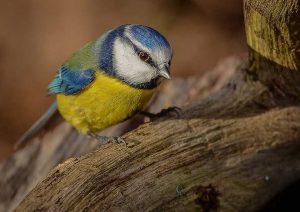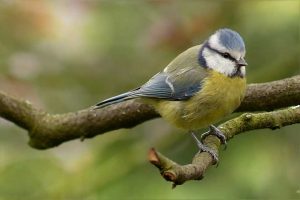When spring is in the air, the bird community is at its liveliest. The race is on for every species to find a mate, build a nest, and raise a brood while food is plentiful.
The blue tit might be an exception. The tiny, instantly recognisable bird begins it’s hunt for a safe nesting site as early as the previous winter.
If you have spotted regular activity in your garden at unusual times of the year, you might wonder where do blue tits nest and do they use bird boxes.

Blue tits are cavity nesters. They choose to make their nest within a ready-made space, favouring hollows in tree trunks or rotting logs. Cracks and crevices in walls and sheds are also inviting to them; they just need space behind to create a safe place to raise their brood. They often inhabit old woodpeckers nests; they reline them and form a soft cup to hold their eggs in place.
Blue tits readily use nesting boxes; a season rarely goes by when I don’t have a family of tits in my garden.
Table of Contents
Do blue tits reuse nests?
When a blue tit has raised a successful brood, it is common to rebuild at the same site the following year. If there are any remnants of the previous nest, they add layers of moss and leaves to pad it out. On top of this, they place spiders webs, feathers, and hair to create a soft lining. The female proceeds to fidget about in the nest to make a well, just big enough to keep the eggs intact.
Being a cavity nester certainly has its benefits as most wind and rain can’t get inside. Maybe this is why blue tits are prolific bird box users. If their boxes have remained in situ, they may return to reuse them. Even if they have been taken down and cleaned before being replaced, the tits might find them in the consecutive year.
It is occasionally possible to see blue tits nesting in old woodpecker nests. They are more robust structures held together tightly with mud.
The tiny birds bury themselves deeply into the side of the nest to avoid being spotted by predators.
In which trees do blue tits nest?
Any tree that has rotted holes could become home to blue tits. They need a narrow gap, just 25mm should do it, to access the cavity behind. The smaller the entrance crack, the more protected they are from the elements and scavengers.
These days, we fill our gardens with small ornamental trees. Given a choice, blue tits make a beeline for the oak. The grand old tree virtually guarantees them a huge crop of fresh insects, just around the time they have many hungry mouths to feed.
Newborn blue tits need as many as 100 caterpillars per day to survive. When you consider that each clutch contains 8-14 eggs, it is understandable that the adult birds need a reliable food source so close to hand.

Do blue tits nest in bird boxes?
The blue tit is one of the most prolific users of nesting boxes. Position it on a tree if possible, but a wall will do. Attach it 2-4 metres high and, if possible, face the entrance hole in a northerly or eastern direction; this protects the birds from wet winds and direct sunlight. Don’t mask the entrance hole too much, blue tits like a clear view before entering and leaving the box.
A 25mm circular doorway is sufficient for their little 10g bodies to squeeze through and keep enemies out.
The sight of blue tits pecking at entrance holes is commonplace. It is usually their way of assessing the strength and durability of the house for their brood.
If it happens during spring it is thought to be part of the male’s display, when he is attempting to impress his lady.
Will more than one family of blue tits nest in the same garden?
They are territorial birds, but only amongst other blue tits. Consequently, it is unlikely that one standard-size garden will house more than one family of blue tits.
The theory is that when food supplies are scarce, adult birds need to ensure there is enough for their young.
However, if you have multiple bird boxes, you might see other birds use the second one. Coal tits are cavity nesters that frequent bird boxes. As they have no ‘beef’ with blue tits, it is common for them to share a garden.
Ensure the nesting boxes are distanced, and to prevent fighting or confusion, have different entrance holes, 25mm and 28mm is a good mix.
Nesting blue tits – interesting fact
Blue tits prefer to nest in wooded areas due to the high-availability of insects, especially caterpillars. They are driven to gardens by the amount of natural food available, along with the variety and regularity of supplementary food that we offer.
When the birds have mated and the nest is built, the female settles in to lay her eggs. Now the interesting part – she weighs around 10g, and each of her eggs weighs 1g each. She will lay as many as 14 eggs, but only 1 per day.
She doesn’t begin to incubate the eggs until she has laid the last egg; the first eggs might lie dormant for 2-weeks before the embryo develops!
She incubates them for 15-days before they hatch.
Now we see why blue tits nest inside cavities; they spend such a long time there that they need robust and secure surroundings, safe from the elements.
Final thoughts
Now that we understand a little more about where blue tits nest and their building habits, it might be a little easier to spot them as they go about the process.
Remember, blue tits have already found their nesting site long before many other birds. To secure your chance of seeing a couple rear their brood, have your bird boxes ready in time for Valentine’s Day.
